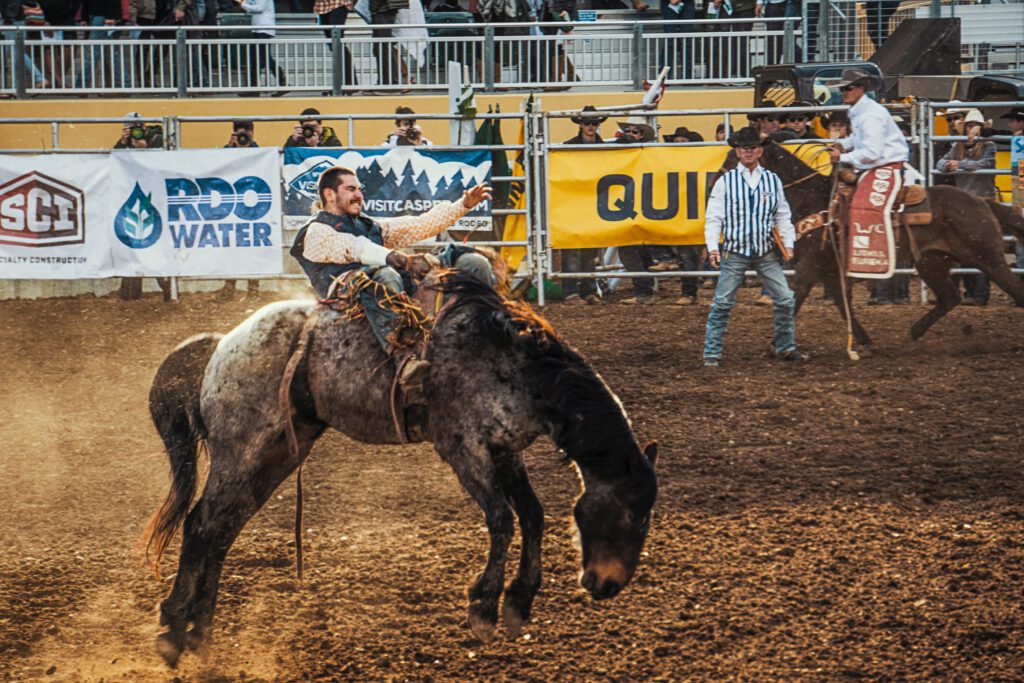Like many other equestrian disciplines, rodeo has its roots in the daily life of men whose main work tool has always been the horse. A true national sport, capable of stealing the show from many popular team sports, rodeo is rooted in the traditions of North America. It was a distraction for the cowboys during their days of rest at the ranch, a pastime to fill the long days of waiting at the end of the trail before the cattle were loaded, all challenges were launched so that everyone could measure their skill and bravery. For the pleasure of the game and the thrill of it, the spectators were more numerous. From a simple private entertainment, these challenges between man and animal became a public show, a competition with official organizers and well established rules.

The various categories of Rodeo
Each event is divided into two parts: the style events and the timed events, each comprising several categories. Western riding is still a different discipline.
Rodeo: The style events
At the opening of the rodeo, we find the saddle bronc riding. With one hand in the air and the other holding a short lead rope connected to the horse’s halter, the cowboy must, in the purest style, resist in the saddle to the fearsome rushes and sudden contortions of his mount for eight to ten seconds.
The bareback bronc riding, as its name indicates, is a raw event, even more spectacular than the previous one. The horse is only harnessed to the saddle with a girth equipped with a handle that the rider must hold with one hand, the other having to remain in the air. Here, the competitor’s style is “free”, the goal being to stay on the horse’s back during the imposed time.
The last event of this first part is the bull riding, in which the cowboy performs the same feats, but on the back of a wild bull.
The judges consider the performance of the riders, but also that of the horses, from which they expect all the ardor, aggressiveness and energy that will make the event brilliant. The more violently the horse tries to get rid of its rider, the higher the score.
Despite the criteria of strong character and vigor that dictate the choice of horses for rodeo, such ruins cannot be obtained without the use of a strap that compresses the horse’s lower abdomen during the test. Thus embarrassed, the animal does everything to get rid of it.
Rodeo: Timed tests
It is no longer a question of wild horses, but of remarkably trained mounts, perfectly complicit with their rider.
Although the cowboys are used to these actions in their everyday life on the ranch, they must consider their speed of execution, which is the key to victory.
Rodeo: calf roping
In calf roping, the competitor chases a calf and lassoes it before jumping to the ground to lay it down and bind three limbs (your choice) to immobilize it. The horse’s job is to back up as soon as the rider steps on the ground and to keep the lasso taut so that the cowboy can grab the calf as quickly as possible. The synchronization of the gestures between horse and rider is essential.
Rodeo: team roping
The team roping is contested by teams of two riders. They start chasing a calf and each rider must lasso one end of the animal. The clock stops as soon as the calf is off balance and on the ground.
The most impressive event is the steer wrestling. Two riders at full gallop must catch up with a young bull. While one of the two competitors controls the straightness of the bull’s trajectory, the other leans, still at full gallop, towards the head of the beast to seize it by the horns, before letting himself slide to the ground, legs forward, to plant his heels in the ground and succeed in immobilizing the bull. He must then knock the bull down, with all four feet in the air. Speed, flexibility, bravery, and precision are essential to win. For a long time, rodeo was exclusively reserved for men, but it has finally accepted the participation of women. For the moment, cowgirls are only accepted in one event reserved for them: barrel racing. It is then for these emeritus riders to go around as quickly as possible the 3 barrels arranged in a triangle on a course in the shape of a clover leaf or simply aligned for an evolution in the shape of a serpentine.
For more information : the rodeo


